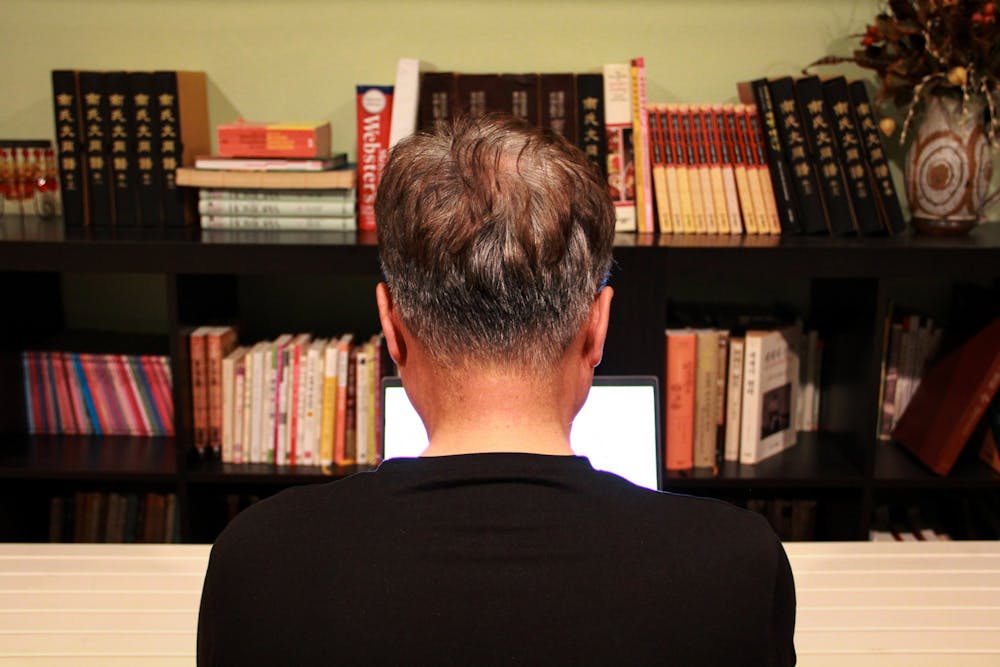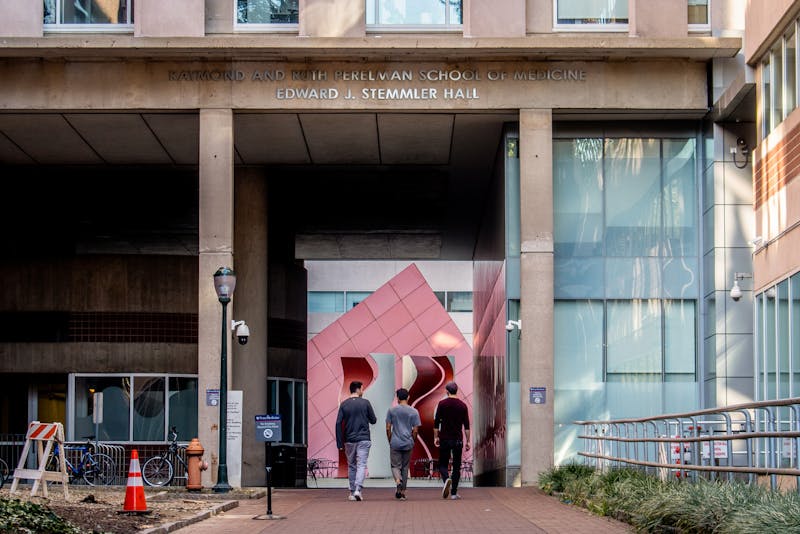
Professors have had to dedicate more time to creating materials and organizing their courses because of the pandemic.
Credit: Stephanie Jungyeon NamLast week, students in STEM classes reported being slammed by the increased workload due to the combination of synchronous and pre-recorded lectures. Behind the scenes, however, some professors say they are working double or triple the usual amount to run a fully virtual course.
In his 12 years at Penn, Math professor Robert Ghrist said teaching has never been more difficult. His working day starts at 4:30 a.m. when he begins preparing material for his courses Math 114: Calculus, Part II and Electrical and Systems Engineering 210: Introduction to Dynamic Systems. The hours before dawn are the quietest, and he cannot afford to re-shoot a few hours' worth of lecture recordings because of an errant car.
“Creating video lectures is different from what I usually do," Ghrist said. "I’m a mathematician. I’m used to working up at a chalkboard."
Ghrist said the Math department has replaced infrequent, high-stake midterms with weekly quizzes to make sure students are keeping up with the material and reduce their stress during the virtual semester. This transition, however, has tripled the workload for Math professors to generate assessments every week.
“The effect of this on the professor side is that we’re always working on writing the next set of quiz questions,” he said. “Because we’re accommodating people in multiple time zones, we’re writing multiple distinct quizzes."
Accounting professor Mirko Heinle, who teaches Accounting 102: Strategic Cost Analysis, said he has also experienced an increased workload this semester, having been forced to redesign his lectures and assessments.
“All of the test procedures and rules I’ve come up with are thrown out of the window [now that everything is virtual],” Heinle said. “Everything has to be redesigned from the get-go.”
In order to make his lectures more digestible to students in a virtual setting, Heinle broke up his usual 80-minute-long lectures into three to five short videos and one 40-minute synchronous class session.
Both Heinle and Ghrist, who teach over 200 students each, cited their large class sizes as a reason for their increased workload, as they have to accommodate a larger number of students in different time zones and with personal situations. Ghrist said, however, the large class sizes do not deter his motivation to teach.
“I volunteered to teach these large lecture courses. It would be very easy for me to teach a research seminar, but I love teaching first and second-year students,” Ghrist said. “I love teaching large intro courses, because it’s a great way to get to know lots of our students.”
Burdened by the combination of synchronous class sessions and pre-recorded lectures, students in STEM classes said the increased workload and time "in class" has forced them to drop classes, work fewer hours at their jobs, and hone their time-management skills.
Both Ghrist and Heinle said they are well aware of students' struggles with the workload this semester and implemented new technology to help students with online learning.
Ghrist said math courses have started to rely more on Piazza, an online discussion platform that allows students to post questions with pictures of their work and receive immediate feedback from professors and teaching assistants.
“This [use of new technology], I think, is one of the lasting benefits of this experiment in remote learning,” Ghrist said. “Professors are going to learn more about Canvas and Piazza in order to improve the classroom environment.”
Heinle, who also uses Piazza, said that of the five major tests students must take in ACCT 102, the lowest score will be dropped and not counted toward their final grade in hopes to reduce students' stress during an already challenging online semester.
Both professors offered some words of advice and encouragement to students struggling with the workload this semester.
“Don’t be discouraged,” Ghrist said. “What matters is not the difficulties you face, but how you respond to them.”
He also advised his students to regulate their sleep schedules and seek positive social interactions. He added that students should not hesitate to reach out to their professors, teaching assistants, and other students for help.
“Ultimately, you need to balance things,” Heinle said. “If it’s too much for you, then learn a little less. If you keep on going, you’re going to shut down.”
Beyond the scope of STEM classes, however, professors teaching humanities courses do not report a significant increase in workload and are overall satisfied with the online semester.
English professor Weike Wang teaches ENGL 010: Intro to Creative Writing and ENGL 115: Advanced Fiction Writing: Auto-Fiction. Wang said the time that would have been spent commuting to campus now goes toward preparing for the course, allowing her to start reading response papers earlier than she normally could during an in-person semester.
Philosophy, Politics, and Economics professor Giuseppe Danese, who is teaching 17 students between his two courses PPE 471: Political Economy — Organizations and PPE 402-303: Research in PPE: The Gift, agreed that the online format does not pose any major challenges for him. He added that he believes his students are spending the same amount of time on classwork than if it was conducted in person.
"Classes run exactly the same way this semester as they did in previous semesters," Danese said. "I believe [virtual learning] doesn't impede the learning objectives for the class."
Despite the relatively smooth transition to online learning, both Wang and Danese have found it harder to engage their students during class discussions and feel the loss of the dynamic classroom environment.
“It’s like a blessing and a curse,” said Wang. “I’ve become more organized and it’s saved me a lot of stress. On the other hand, I feel like the camaraderie is a little bit lost.”
The virtual fall semester has affected both sides of the lecture hall, with students and professors alike beset by increased workloads. In these unprecedented times, Ghrist commended students for their resilience and willingness to excel despite the virtual academic setting.
“One thing I’m most looking forward to is the day when we’re all finally back on campus and I can meet all of these students I’ve had glimpses of through the screen,” he said. “I want to meet them and shake their hand and say ‘You did a really good job, I’m proud of you.’ That’s what I’m looking forward to."
The Daily Pennsylvanian is an independent, student-run newspaper. Please consider making a donation to support the coverage that shapes the University. Your generosity ensures a future of strong journalism at Penn.
Donate







